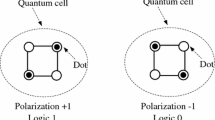Abstract
Quantum-dot Cellular Automata (QCA) is an emerging nanotechnology to replace VLSI-CMOS digital circuits. Due to its attractive features such as low power consumption, ultra-high speed switching, high device density, several digital arithmetic circuits have been proposed. Adder circuit is the most prominent component used for arithmetic operations. All other arithmetic operation can be successively performed using adder circuits. This paper presents Shannon logic based QCA efficient full adder circuit for arithmetic operations. Shannon logic expression with control variables helps the designer to reduce hardware cost; using with minimum foot prints of the chip size. The mathematical models of the proposed adder are verified with the theoretical values. In addition, the energy dissipation losses of the proposed adder are carried out. The energy dissipation calculation is evaluated under the three separate tunneling energy levels, at temperature T = 2K.The proposed adder dissipates less power. QCAPro tool is used for estimating the energy dissipation. In this paper we proposed novel Shannon based adder for arithmetic calculations. This adder has been verified in different aspects like using Boolean algebra besides it power analysis has been calculated. In addition 1-bit full adder has been enhanced to propose 2-bit and 4-bit adder circuits.












Similar content being viewed by others
References
Allan, A., Edenfeld, D., Joyner, W.H., Kahng, A.B., Rodgers, M., Zorian, Y.: 2001 technology roadmap for semiconductors. Computer 35(1), 42–53 (2002)
Lent, C.S., Tougaw, P.D., Porod, W., Bernstein, G.H.: Quantum cellular automata. Nanotechnology 4(1), 49 (1993)
Tougaw, P.D., Lent, C.S.: Logical devices implemented using quantum cellular automata. J. Appl. Phys. 75(3), 1818–1825 (1994)
Hashemi, S., Navi, K.: A novel robust QCA full-adder. Prog. Mater. Sci. 11, 376–380 (2015)
Niemier, M.T., Kogge, P.M.: Problems in designing with QCAs: Layout = timing. Int. J. Circuit Theory Appl. 29(1), 49–62 (2001)
Zhang, R., Walus, K., Wang, W., Jullien, G.A.: Performance comparison of quantum-dot cellular automata adders. In Circuits and Systems, 2005. ISCAS 2005. IEEE International Symposium on (pp. 2522-2526). IEEE (2005)
Azghadi, M.R., Kavehie, O., Navi, K.: A novel design for quantum-dot cellular automata cells and full adders. arXiv:1204.2048 (2012)
Abedi, D., Jaberipur, G., Sangsefidi, M.: Coplanar full adder in quantum-dot cellular automata via clock-zone-based crossover. IEEE Trans. Nanotechnol. 14(3), 497–504 (2015)
Cho, H., Swartzlander, E.E., Jr.: Adder and multiplier design in quantum-dot cellular automata. IEEE Trans. Comput. 58(2), 721–727 (2009)
Ahmad, F., Bhat, G.M., Khademolhosseini, H., Azimi, S., Angizi, S., Navi, K.: Towards single layer quantum-dot cellular automata adders based on explicit interaction of cells. J. Comput. Sci. 16, 8–15 (2016)
Nehru, K., Shanmugam, A., Deepa, S., Priyadarshini, R.: A shannon based low power adder cell for neural network training. Int. J. Eng. Technol. 2(3), 258 (2010)
Das, J.C., De, D.: Shannon’s expansion theorem-based multiplexer synthesis using QCA. Nanomater. Energy 5(1), 53–60 (2016)
Perri, S., Corsonello, P., Cocorullo, G.: Area-delay efficient binary adders in QCA. IEEE Transactions on very large scale integration (vlsi) systems 22(1), 1174–1179 (2014)
De, D., Das, J.C.: Design of novel carry save adder using quantum dot-cellular automata. J. Comput. Sci. 22, 54–68 (2017)
Dysart, T.J., Kogge, P.M.: Probabilistic analysis of a molecular quantum-dot cellular automata adder. In: Defect and fault-tolerance in vlsi systems, 2007. DFT’07. 22nd IEEE International Symposium on (pp. 478-486). IEEE (2007)
Farazkish, R., Khodaparast, F.: Design and characterization of a new fault-tolerant full-adder for quantum-dot cellular automata. Microprocess. Microsyst. 39(2), 426–433 (2015)
Lombardi, F., Huang, J., Ma, X., Momenzadeh, M., Ottavi, M., Schiano, L., Vankamamidi, V.: Design and test of digital circuits by quantum-dot cellular automata. In: Lombardi, F., Huang, J. (eds.) . UK, Norwood (2008)
Bennett, C.H.: Logical reversibility of computation. IBM J. Res. Dev. 17(2), 525–532 (1973)
Roohi, A., DeMara, R.F., Khoshavi, N.: Design and evaluation of an ultra-area-efficient fault- tolerant QCA full adder. Microelectron. J. 46, 531–542 (2015)
Ambika, G., Shanthala, G.M., Sharan, P., Talabattula, S.: An optimized design of complex multiply-accumulate (MAC) unit in quantum dot cellular automata (QCA). In: Silicon photonics & high performance computing, pp 95–102. Springer, Singapore (2018)
Wang, W., Walus, K., Jullien, G.A.: Quantum-dot cellular automata adders. In: Nanotechnology, 2003. IEEE-NANO 2003. 2003 3rd IEEE Conference on (vol. 1, pp. 461–464). IEEE (2003)
Tougaw, P.D., Lent, C.S.: Logical devices implemented using quantum cellular automata. J. Appl. Phys. 75(3), 1818–1825 (1994)
Vetteth, A., Walus, K., Jullien, G.A., Dimitrov, V.: Quantum dot cellular automata carry-look-ahead adder and barrel shifter, Proceed. IEEE Emerging Telecommun. Technol. Dalla TX.2-I-4 (2002)
Srivastava, S., Asthana, A., Bhanja, S., Sarkar, S.: QCAPro - An error-power estimation tool for QCA circuit design, IEEE International Symposium of Circuits and Systems (ISCAS), pp. 2377–2380 (2011)
Timler, J., Lent, C.S.: Power gain and dissipation in quantum-dot cellular automata. J. Appl. Phys. 91(2), 823–831 (2002)
Srivastava, S., Sarkar, S., Bhanja, S.: Estimation of upper bound of power dissipation in QCA circuits. IEEE Trans. Nanotechnol. 8(1), 116–127 (2009)
Author information
Authors and Affiliations
Corresponding author
Rights and permissions
About this article
Cite this article
Kandasamy, N., Ahmad, F. & Telagam, N. Shannon Logic Based Novel QCA Full Adder Design with Energy Dissipation Analysis. Int J Theor Phys 57, 3702–3715 (2018). https://doi.org/10.1007/s10773-018-3883-3
Received:
Accepted:
Published:
Issue Date:
DOI: https://doi.org/10.1007/s10773-018-3883-3




